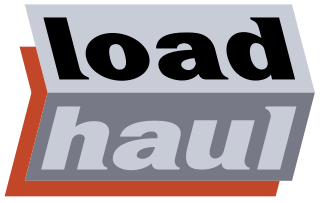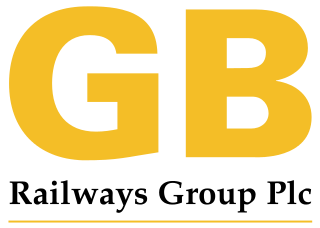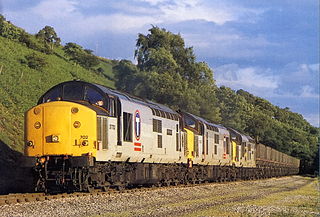British Railways (BR), which from 1965 traded as British Rail, was a state-owned company that operated most of the overground rail transport in Great Britain from 1948 to 1997. It was formed from the nationalisation of the Big Four British railway companies, and was privatised in stages between 1994 and 1997. Originally a trading brand of the Railway Executive of the British Transport Commission, it became an independent statutory corporation in January 1963, when it was formally renamed the British Railways Board.

The railway system of Great Britain started with the building of local isolated wooden wagonways starting in the 1560s. A patchwork of local rail links operated by small private railway companies developed in the late 18th century. These isolated links expanded during the railway boom of the 1840s into a national network, although still run by dozens of competing companies. Over the course of the 19th and early 20th centuries, these amalgamated or were bought by competitors until only a handful of larger companies remained. The entire network was brought under government control during the First World War and a number of advantages of amalgamation and planning were demonstrated. However, the government resisted calls for the nationalisation of the network. In 1923, almost all the remaining companies were grouped into the "Big Four": the Great Western Railway, the London and North Eastern Railway, the London, Midland and Scottish Railway and the Southern Railway. The "Big Four" were joint-stock public companies and they continued to run the railway system until 31 December 1947.

DB Cargo UK, is a British rail freight company headquartered in Doncaster, England.
The privatisation of British Rail was the process by which ownership and operation of the railways of Great Britain passed from government control into private hands. Begun in 1994, it had been completed by 1997. The deregulation of the industry was initiated by EU Directive 91/440 in 1991, which aimed to create a more efficient rail network by creating greater competition.

British Rail was the brand image of the nationalised railway owner and operator in Great Britain, the British Railways Board, used from 1965 until its breakup and sell-off from 1993 onwards.

Loadhaul Ltd. was a railfreight operator based in the north-east of the United Kingdom. It was formed in 1994, as part of the privatisation of British Rail, and acquired in 1996 by a consortium headed by Wisconsin Central, then merged into a new company English Welsh & Scottish Railway. It is now part of DB Cargo.

Transrail was a trainload rail freight operator based in St Blazey, England, UK with a large operating area including Scotland, Wales and the west of England. It was formed in 1994 from part of British Rail's Trainload Freight division, as part of the privatisation of British Rail.

Mainline Freight was a trainload rail freight operator based in Islington, London, England with operations extending to Yorkshire in the north and Somerset in the west. It was formed from part of British Rail's Trainload Freight division as part of the privatisation of British Rail.

Railfreight Distribution was a sub-sector of British Rail, created by the division in 1987 of British Rail's previous Railfreight sector. It was responsible for non-trainload freight operations, as well as Freightliner and Intermodal services. In its early years, the division was occasionally referred to as Speedlink Distribution. It was later responsible for freight operations through the Channel Tunnel.

The British Rail Class 92 is a dual-voltage electric locomotive, which can run on 25 kV AC from overhead wires or 750 V DC from a third rail. It was designed specifically to operate services through the Channel Tunnel between Great Britain and France. Eurotunnel indicates the Class 92 locomotive as the reference for other locomotives which railway undertakings might want to get certified for usage in the Channel tunnel.
The history of rail transport in Great Britain 1948–1994 covers the period when the British railway system was nationalised under the name of 'British Railways', latterly known as British Rail until its eventual privatisation in 1994.

GB Railfreight (GBRf) is a rail freight company in the United Kingdom. As of 2022, it is owned by the global investment company Infracapital.

Wisconsin Central Ltd. is a railroad subsidiary of Canadian National. At one time, its parent Wisconsin Central Transportation Corporation owned or operated railroads in the United States, Canada, the United Kingdom, New Zealand, and Australia.

Railfreight was a sector of British Rail responsible for all freight operations on the British network. The division was created in 1982 when BR sought to assign particular stock and management to the evolving requirements of freight traffic.

GB Railways was the parent company of a number of train operating companies, running the Anglia Railways franchise from January 1997 and launching Hull Trains and GB Railfreight. GB Railways was also involved in the management of the Estonian rail company Edelaraudtee and had an investment in Great Southern Rail in Australia.
Speedlink was a wagonload freight service operated by British Rail from 1977 to 1991 using air-braked wagons.
In rail freight transportation the terms wagonload or wagonload freight refer to trains made of single wagon consignments of freight. In the US and Canada the term carload refers to a single car of any kind, and manifest train refers to trains made of diverse cars of freight.

The railway network in Great Britain has been used to transport goods of various types and in varying volumes since the early 19th century. Network Rail, which owns and maintains the network, aims to increase the amount of goods carried by rail. In 2015–16 Britain's railways moved 17.8 billion net tonne kilometres, a 20% fall compared to 2014–15. Coal accounted for 13.1% of goods transport in Britain, down considerably from previous years. There are no goods transported by railway in Northern Ireland.
Travellers Fare was a company owned by British Rail that provided catering services on the rail network in Great Britain.

Intermodal railfreight in Great Britain is a way of transporting containers between ports, inland ports and terminals in England, Scotland and Wales, by using rail to do so. Initially started by British Rail in the 1960s, the use of containers that could be swapped between different modes of transport goes back to the days of the London, Midland & Scottish Railway.
























